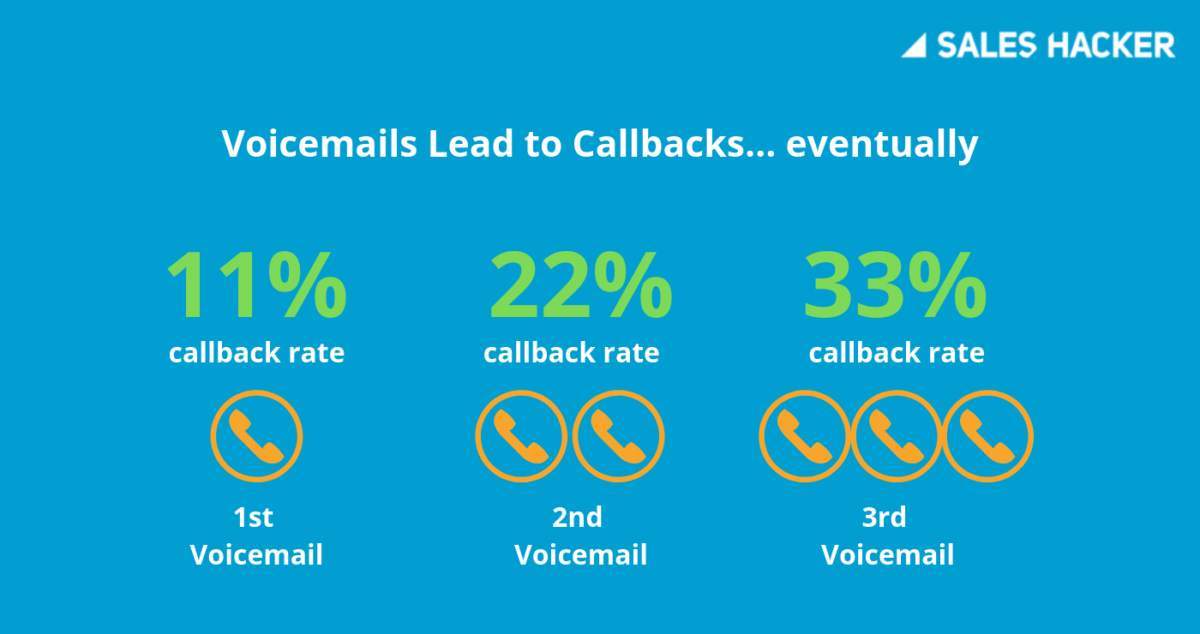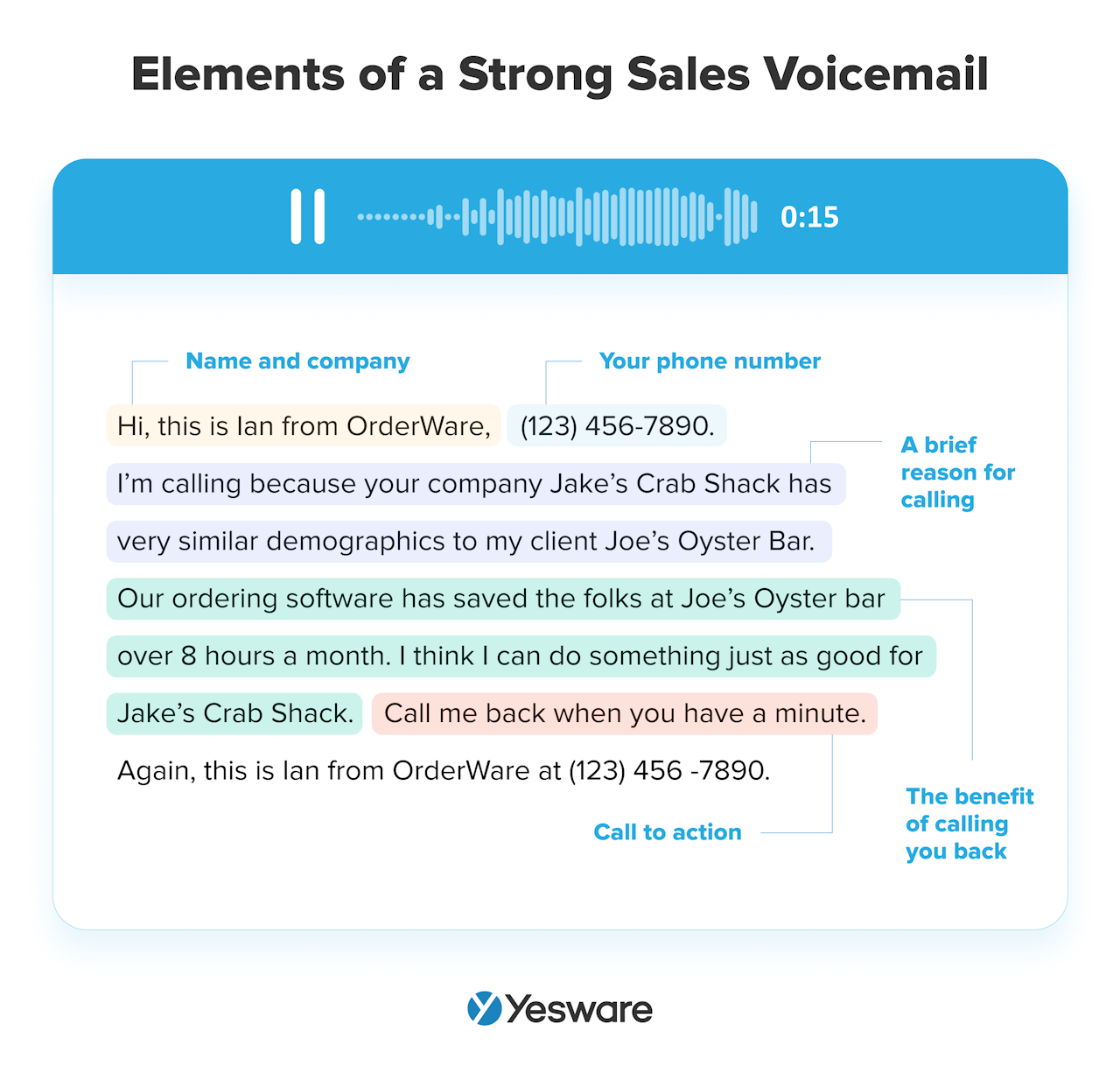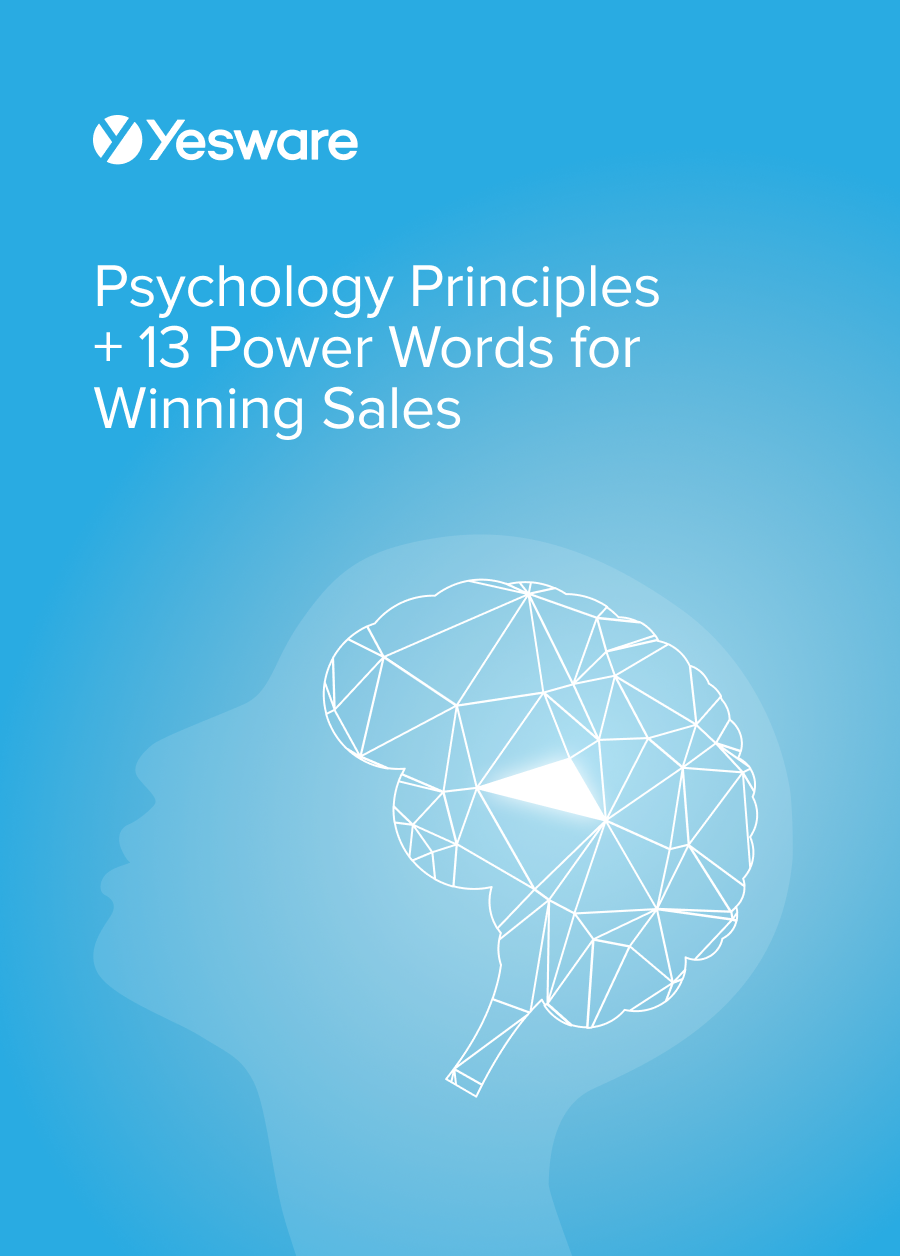15 Sales Voicemail Scripts That Get Callbacks
Casey O'Connor
Sales voicemail scripts help salespeople stay on track when they leave a message for a prospect.
An effective sales voicemail script can be the difference between a lost prospect and a sales opportunity.
In this article, we’ll go over everything you need to know about sales voicemail scripts, including what they are, why they’re so important, and 15 templates to use in your calls today.
Here’s what we’ll cover:
- What Is a Sales Voicemail Script?
- Why Sales Voicemails Are Important
- Elements of a Strong Sales Voicemail
- 15 Sales Voicemail Scripts
- Sales Voicemail Tips
What Is a Sales Voicemail Script?
A sales voicemail script is pretty self-explanatory; it’s a pre-written series of sentences that are strategically created with the intention of preparing a salesperson to leave an effective, callback-worthy voicemail for a prospect or customer.
It’s much better to use a sales voicemail script when you reach an answering machine than it is to wing it and say whatever comes to mind.
Why Sales Voicemails Are Important
The fact of the matter is that sales reps are far more likely to leave a sales voicemail than they are to speak directly to a prospect; sales calls go to voicemail 97% of the time.
There is simply no getting around the fact that all sales reps will need to leave at least one voicemail nearly every day in their sales career.
In fact, the average sales rep leaves a whopping 70 voicemails per day.
But just because it’s something you do every day doesn’t mean that your voicemails should be casual. Effective sales voicemails are an extremely important component of a successful sales process.
Sales voicemails are important because they:
- Show you care: Most people these days don’t leave voicemails unless it’s something really important. By leaving a sales voicemail, reps can give the impression that their offer is well worth leaving a message for.
- Improve your brand recognition: Including your company name in your voicemail script can help prospects become more aware of your brand. This is subtle, but anything that keeps your brand top-of-mind for a prospect is a win.
- Increase the chances of getting a callback: Effective voicemails really increase a sales rep’s chances of getting a call back from the prospect. In fact, for each voicemail a sales rep leaves, their callback chances go up by 11%.

Leaving a voicemail is also just the professional thing to do. When cold calling prospects, it’s annoying for them to get frequent missed calls from an unknown caller who doesn’t leave a message to identify themself. Voicemails help sales reps leave a professional, respectful impression on the prospect.
Elements of a Strong Sales Voicemail
The specifics of each sales voicemail will vary by the sales rep’s personality and the circumstances around their outreach.
That being said, there are a few components that are crucial for any successful sales voicemail:
- Name and company: Some sales reps prefer to lead with this information, and then repeat it at the end of the voicemail.
- Your phone number: Again, some reps opt to share this information twice, once at the beginning and once at the end of the voicemail.
- A brief reason for calling: This will be unique to each prospect/call (unless you’re being strategically mysterious — more on that in the next section).
- The benefit of calling you back: In other words — what’s in it for them? What does the prospect get from picking up the phone to call you? Will they gain time? More revenue? Better productivity?
- Call to action: What do you want the prospect to do after they get your message — call you back? Check their email? Go to a webpage? Make sure you direct them to where you’d ideally want them to end up next.
Let’s see these in action:  Grab the template for this sales voicemail script and more below.
Grab the template for this sales voicemail script and more below.
15 Sales Voicemail Scripts
Here are 15 of the most common sales voicemail scripts that salespeople might find effective in their daily calls.
The Credibility Plug
A quick way to establish rapport through voicemail is by giving some context to your credibility. In other words, share (quickly) with the listener why they should listen to your message.
Hi [prospect name], [your name] at [your company name] here. We spoke [at X convention/on X date]. Wanted to chat further about a couple of things, give me a call when you have a minute. Again, [your name] at [your company name], [your phone number]. Talk soon.
You can also get some credibility by offering a (very quick) peek at some of the results you’ve generated from similar clients.
Hi, this is [your name] with [your company name], [your phone number]. I’m calling because your company [prospect’s company name] came up as very similar to [your client who shares demographics with prospect]. I’ve helped [your client] [impressive result from using your product]. I think I can do something similar for [prospect’s company name]. Call me back when you have a minute. Again, this is [your name] at [your phone number].
That’s a bit hard to digest with all the brackets — here’s how it might sound in action:
Hi, this is Ian from OrderWare, (123) 456-7890. I’m calling because your company Jake’s Crab Shack has very similar demographics to my client Joe’s Oyster Bar. Our ordering software has saved the folks at Joe’s Oyster bar over 8 hours a month. I think I can do something just as good for Jake’s Crab Shack. Call me back when you have a minute. Again, this is Ian from OrderWare at (123) 456 -7890.
Just make sure this is authentic, and that it doesn’t violate any NDAs. And don’t over-divulge.
The Mystery
A sales voicemail with a mysterious tone can be effective in some scenarios. It’s on the
more controversial side (as far as voicemails go), because it can lead some prospects to feel manipulated when they call you back expecting an emergency and get a sales pitch instead.
Still, though, it works well with certain market segments. Your ICP and buyer personas can help you determine how effective this strategy might be with your target market.
Hi [prospect name], this is [your name] at [your company name]. Call me back please at your earliest convenience please, it’s urgent. [Your phone number]. Again, [your phone number].
This kind of voicemail might pique someone’s interest — not many people demand an urgent call back, especially without referencing the reason for calling.
Intentionally omitting most components of a sales voicemail can create an air of mystery, and might be just compelling enough to get the prospect to call you back.
Some, though, might be annoyed to find out that their definition of “urgent” doesn’t quite match yours, so use with caution.
The Urgency Appeal
Fortunately, there are ways to create urgency without relying on too much mystery. You can always be straightforward with prospects and let them know how eager you are to speak with them.
Hi [prospect name], this is [your name] at [your company name]. I’m trying desperately to reach you by close of business today. Please call me back at your earliest convenience. It will only take five minutes, but it’s time-sensitive. My number is [your number]”
Creating a deadline can be a trigger for some prospects, and prompt them to call you back. Just make sure that you use this authentically — don’t impose an arbitrary COB deadline for something that can be handled by the end of the week. And make sure you pick up when they call you back.
The Referral
Name-dropping a referral can be a very successful tactic for getting prospects to call you back. This sales voicemail script does just that.
Hi [prospect name], this is [your name] at [your company name]. [Mutual contact] gave me your number and suggested I reach out. I [briefly describe your role and results you get for clients]. I think we could be a good fit. Give me a call back when you have a minute, [your phone number]. Again, [your name], [your phone number].
Not only does mentioning your contact’s name give you credibility, it also adds a hint of social pressure. No one wants to blow off a mutual acquaintance.
The Straightforward Introduction
Many sales voicemails are perfectly effective with a straightforward approach.
Hi [prospect name], this is [your name] at [your company name]. I [briefly describe your role and results you get for clients]. I think we could be a good fit. Give me a call back when you have a minute, [your phone number]. Again, [your name], [your phone number]. Thanks [prospect name].
Remember to keep it short and sweet — this isn’t a pitch, it’s an introduction.
The Value Offer
You can score a lot of points from a prospect by using your sales voicemail to tell them you delivered value to them via email.
Hi [prospect name], this is [your name] at [your company name]. I just emailed you a brief report on [prospect’s company name]. I think you’ll find it insightful, it certainly was for me. Give me a call back when you have a minute to discuss, [your phone number]. Again, [your name], [your phone number].
One benefit to this strategy is that many prospects will choose the lesser of two evils and reply via email instead of by phone. It’s a lot harder to ignore outreach attempts through two different channels — especially from someone who’s gone through the trouble of generating a personalized report.
The FOMO
You could also adapt that value voicemail script strategy and create some FOMO by sharing another client’s case study.
Hi [prospect name], this is [your name] at [your company name]. I just emailed you a brief report on [client’s company name]. I think you’ll find it insightful. Their story reminded me of yours. Give me a call back when you have a minute to discuss. My number is [your phone number]. Again, [your name], [your phone number].
Make sure you select a case study that’s likely to resonate with that specific prospect.
The Inquiry Follow-up
Inbound leads are usually a lot easier to leave voicemails for than outbound ones, because you already know they’re interested.
Use this sales voicemail script for prospects who have already made some kind of contact with your brand.
Hi [prospect name], this is [your name] at [your company name]. I just wanted to follow-up and get your feedback on [content viewed by prospect]. Give me a call back when you have a chance, I’d appreciate it. [Your phone number]. Again, [your name], [your company name]. [your phone number].
If the prospect is a good fit for your brand, and your content is good, chances are high that they’ll call you back. It just might be on their own timeline.
The Outreach Follow-up
Unfortunately, outbound leads aren’t always as easy to approach. These sales voicemail scripts can feel a bit more tedious. Remember, though — the more voicemails you leave, the better your chances become of getting a call back.
Hi [prospect name], [your name] at [your company name]. I sent you an email yesterday/called you yesterday but didn’t hear back yet. Can you call me back by the end of the day for a quick chat? Again, this is [your name] at [your company name]. My number is [your number]. Thanks a lot.
This sales voicemail script can be tweaked for several iterations if you need to use it more than once.
The Yes-Or-No
This approach is just unconventional enough to potentially generate a better-than-average callback rate, depending on the market. All you have to do is ask the prospect point-blank: yes or no?
Hi [prospect name], this is [your name] at [your company name]. I emailed you last week about [your product] but haven’t heard back. I don’t want to waste anyone’s time, so shoot me a reply when you have a chance — all you have to say is “Yes” or “No” and we’ll proceed accordingly. Thanks [prospect name], looking forward to hearing from you.
If the prospect can push one thing off their plate by replying with one word, they just might go for it.
The Trigger Event
It’s always a plus when there’s a “trigger event” you can use to segue into your voicemail.
The sales voicemail script for this scenario sounds something like this:
Hi [prospect name], this is [your name] at [your company name]. [Trigger event just happened]. Call me back when you have a minute, [your number]. Again, [your name], [your phone number].
Here’s what it might look like in action.
Hi Meg, this is Jennifer at BotWorth. I just read the article you shared on LinkedIn and found it fascinating. I’d love to talk more about auto-filters on CRM platforms. Call me back when you have a minute, (123) 456-7890. Again, Meg, (123) 456-7890.
Here’s another example.
Hi [prospect name], this is [your name] at [your company name]. I just read the news that [prosect’s company name] [prospect’s company’s big achievement]. Incredible news. Let’s talk when you have a minute. Call me back, [your number]. Again, [your name], [your phone number].
This strategy goes a long way in building rapport without any input at all from the prospect.
The Warning Call
Sometimes a voicemail can help set you up for success the next time you call. You can use one voicemail to give the prospect a warning about the next time you’re going to call so they can pencil it in.
Hi [prospect name], this is [your name] at [your company name]. I [briefly describe your role and results you get for clients]. I think we could be a good fit. I’ll try you again on [date/time]. If you want to talk before then, you can reach me at [your number]. Again, [your name], [your phone number].
The Cross-Sell/Upsell
You can also use a sales voicemail script to help sell a new product to an existing customer.
Hi [prospect name], this is [your name] at [your company name]. I’m so glad you’re still having success with [current product]. Just heard that we’re introducing [new/upgraded product]. I think this could work well for you. Call me back. Again, [your name], [your phone number].
You’re 14x more likely to sell to an existing customer than to a new one, so this can be a very lucrative strategy.
The Email Precursor
Sometimes a voicemail can be used as a courtesy to let the listener know that you’re about to send them an email. This can actually give the salesperson an edge, as it helps their email stand out among an undoubtedly busy inbox.
Hi [prospect name], this is [your name] at [your company name]. I’m about to send you an email that includes [relevant/valuable information]. Take a look when you have a minute and let me know what you think. My number is [your number], or email works too. Looking forward to hearing your thoughts.
This sales voicemail script helps prime your message for the listener’s brain and eyes the next time they scan their inbox.
Tip: Grab psychology-backed strategies and power words to win people over.
 Psychology Principles + 13 Power Words for Winning SalesData-backed psychological principles, nonverbal cues, and persuasive phrases to win more deals.
Psychology Principles + 13 Power Words for Winning SalesData-backed psychological principles, nonverbal cues, and persuasive phrases to win more deals.
Sales Voicemail Tips
Keep the following tips in mind as you write and rehearse your sales voicemail scripts.
Avoid Selling
Whatever you do, don’t use voicemail as a sales pitch. This would be doing a disservice to you, your product, and your prospect.
Think of a voicemail as a stepping stone; it helps get you from Point A to Point B with prospects in the sales funnel. Depending on how far along the prospect is in their buyer’s journey, they may need more or fewer of those stepping stones.
Be Succinct
Voicemails should be no longer than 20 seconds. Ideally, most will be capped at 10 seconds.
That being said, don’t speak too quickly for the sake of meeting a certain time frame. Speak intelligibly, especially when you say your name and phone number.
Say Their Name and Yours
You’d be surprised at how many people forget to identify themselves when they leave a voicemail. Get in the habit of starting your voicemail the same way every time, and make sure it includes your name.
Hi, this is [your name] at [company name].
Hey, [your name] at [company name] here.
Hi there, my name is [your name] and I work for [company name].
The verbiage doesn’t matter, but it should be close to identical every time so that you never forget to say your own name.
There’s also a psychological perk to saying the prospect’s name. People love to hear their own names. By starting some voicemails off with the prospect’s name, you automatically get their attention and make them more inclined to listen further.
Leave More Than One Voicemail
Remember that your chances of getting called back with every subsequent voicemail you leave for your recipient. In fact, many sales reps don’t even expect a callback on the first dial. They know it will most likely require more than one.
Be Mindful of Your Tone
Leaving voicemails can get monotonous in a hurry. Be sure to pay careful attention to your tone as you leave voicemails for prospects throughout the day. Take breaks as needed and switch up your segment list every so often to add some variety.
A/B Test Your Sales Voicemail Scripts
You can easily collect data on which sales voicemail scripts are most effective through A/B testing. Your sales team will likely discover over time which words, phrases, and tones of voice resonate most in voicemail with your target market. Voicemails can be tested and optimized for best results.
Do you like leaving sales voicemails? Do you use scripts, or do you make up something new each time? What strategies do you find the most effective?
Get sales tips and strategies delivered straight to your inbox.
Yesware will help you generate more sales right from your inbox. Try our Outlook add-on or Gmail Chrome extension for free, forever!
Related Articles
Anya Vitko
Anya Vitko
Jenny Keohane
Sales, deal management, and communication tips for your inbox

